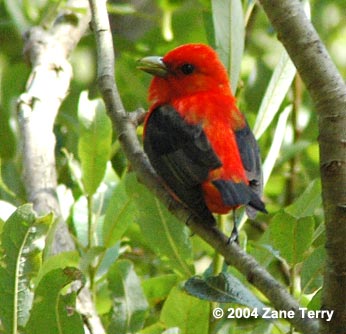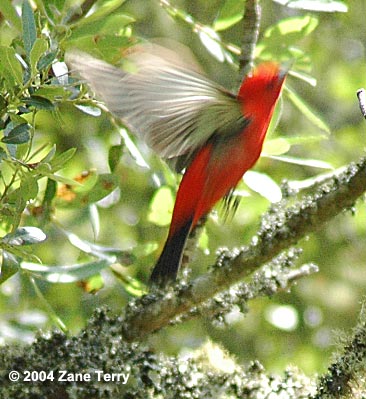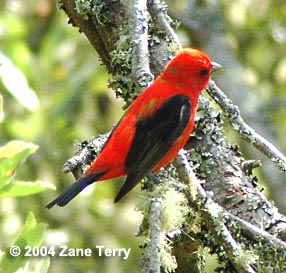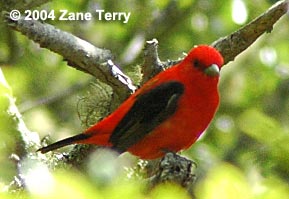Scarlet Tanager (Pirange
olivacea)
San Bruno Mountain State and County Park, San Mateo County, California
11 June 2004
Joseph Morlan
Photos © 11 June 2004 by Zane Terry. All rights reserved.
 This afternoon the weather was clear and windy. Nevertheless, Robbie Fischer and I decided to try
for a singing male Scarlet Tanager reported by Herb Brandt on the Northern California Birdbox. We arrived at San Bruno Mountain
mid-afternoon and walked along the Old Guadalupe Trail where we met Dan Singer and Calvin Lou. They had neither
seen nor heard the bird. I continued on and noticed Herb Brandt talking to Zane Terry along the Bog Trail. I learned
they had seen the bird again about 10 minutes before I got there and that Zane had managed to photograph it. He
showed me the photo in his digital camera and it clearly showed a bright red bird with black wings.
This afternoon the weather was clear and windy. Nevertheless, Robbie Fischer and I decided to try
for a singing male Scarlet Tanager reported by Herb Brandt on the Northern California Birdbox. We arrived at San Bruno Mountain
mid-afternoon and walked along the Old Guadalupe Trail where we met Dan Singer and Calvin Lou. They had neither
seen nor heard the bird. I continued on and noticed Herb Brandt talking to Zane Terry along the Bog Trail. I learned
they had seen the bird again about 10 minutes before I got there and that Zane had managed to photograph it. He
showed me the photo in his digital camera and it clearly showed a bright red bird with black wings.
It turns out that Zane had actually seen the bird earlier in the morning before Herb had seen it. I notified
Robbie by radio and she called Calvin and Dan by cell phone that the bird was at Bog Springs. We waited there about
45 minutes when I heard the Scarlet Tanager singing from the willows. The song was robin-like, but faster and much
huskier. I headed off in the direction of the song along the Lower Bog Trail when I heard the song again behind
me. I headed back and found that Zane had just taken more pictures of the bird. Then the tanager started singin g again along the lower trail.
We headed down there and Calvin saw the bird fly through willows to the bottom of the ravine and disappear.
g again along the lower trail.
We headed down there and Calvin saw the bird fly through willows to the bottom of the ravine and disappear.
Merry and David Haveman arrived. We split up and eventually Herb, Zane and Robbie found the bird along the Bog
Trail just south of the big hairpin turn. I got the radio call from Robbie and raced to the spot where I managed
to miss the bird by a few seconds. The Scarlet Tanager moved back in the willows and seemed to be singing from
the Lower Bog Trail. I headed back over there but the wind was blowing and I didn't hear it any more. I returned
to the spot where Robbie had seen it. Dan was planning to check the lower trail and I was in the process of lending
him a radio when the adult male Scarlet Tanager finally appeared in the willows and Elderberries at fairly close
range. I was able to study it for several minutes and everybody except Merry got good views. Fortunately Merry
spotted the bird again and we got more views. After about 10 minutes Herb found it again further south along the
Bog Trail where it came out into the open, perched on dead snags, and sang against the blue sky. We all enjoyed
the bird while Zane and Dan took more photos. Finally the bird flew up hill to the east toward the Old Guadalupe
Trail.
The following is based on notes taken immediately after watching the bird.
Description
A tanager, about the size and shape of a Western Tanager. The body was almost all red, fairly bright, but not
as deep crimson as some. There were small patches of dull yellow on the nape and scapulars and the red on the belly
faded slightly to yellowish-orange. The wings appeared all black, but the primaries and secondaries were paler
with a grayish cast, and contrasted with the jet black of the wing-coverts. When the bird fluttered to reach for
some Elderberries, I could see whitish wing-linings. The tail appeared blackish above and gray below. The black
eye seemed rather large on the bright red face.
The bill was fairly dark, with a decidedly curved culmen and overall swollen shape typical of Piranga
tanagers. When the bird sang against the sky, and opened its bill, an angled tomium w as evident, but I was not able to detect a distinct tooth.
as evident, but I was not able to detect a distinct tooth.
After my second sighting, the bird started calling, a very distinctive "chip-BURRRRRR" with the "burrrr"
note much lower and slurred. The plumage indicates that it was a first summer bird (SY).
Discussion
This appears to be the first record for San Mateo County.
This is the fourth Scarlet Tanager I have seen in California. My first was a SY male on 20 June 1982 at the
Point Reyes Lighthouse; the second was a HY male on 23 October 1993 at Drake's Beach, Point Reyes; and the third
was a male in mid-July 1994 at Coyote Creek, Santa Clara County.
 This afternoon the weather was clear and windy. Nevertheless, Robbie Fischer and I decided to try
for a singing male Scarlet Tanager reported by Herb Brandt on the Northern California Birdbox. We arrived at San Bruno Mountain
mid-afternoon and walked along the Old Guadalupe Trail where we met Dan Singer and Calvin Lou. They had neither
seen nor heard the bird. I continued on and noticed Herb Brandt talking to Zane Terry along the Bog Trail. I learned
they had seen the bird again about 10 minutes before I got there and that Zane had managed to photograph it. He
showed me the photo in his digital camera and it clearly showed a bright red bird with black wings.
This afternoon the weather was clear and windy. Nevertheless, Robbie Fischer and I decided to try
for a singing male Scarlet Tanager reported by Herb Brandt on the Northern California Birdbox. We arrived at San Bruno Mountain
mid-afternoon and walked along the Old Guadalupe Trail where we met Dan Singer and Calvin Lou. They had neither
seen nor heard the bird. I continued on and noticed Herb Brandt talking to Zane Terry along the Bog Trail. I learned
they had seen the bird again about 10 minutes before I got there and that Zane had managed to photograph it. He
showed me the photo in his digital camera and it clearly showed a bright red bird with black wings. g again along the lower trail.
We headed down there and Calvin saw the bird fly through willows to the bottom of the ravine and disappear.
g again along the lower trail.
We headed down there and Calvin saw the bird fly through willows to the bottom of the ravine and disappear.
 as evident, but I was not able to detect a distinct tooth.
as evident, but I was not able to detect a distinct tooth.